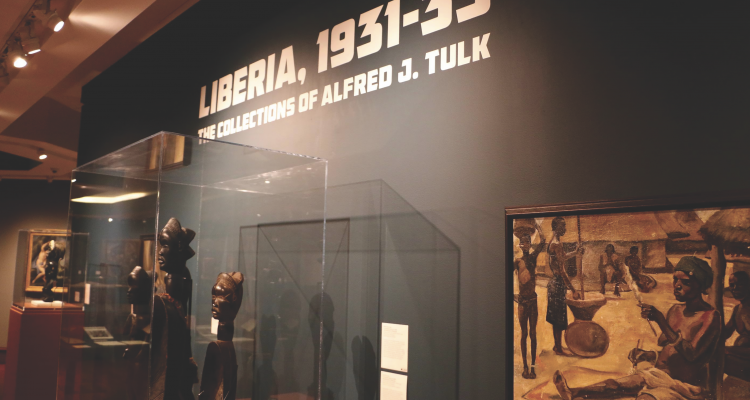When entering Bellarmine Hall for the first time, the experience can be a bit daunting. It’s a big manor, located just a stone’s throw away from many of the academic buildings on campus and stands out among the other mid-century brick buildings dotted along the Fairfield University map.
What you might not know about Bellarmine is that it’s located roughly 4,569 miles from Liberia, a small West African Nation whose culture and history seems out of reach to many of us. At least it was to me, until I arrived at the gallery opening of “Liberia, 1931-33: The Collections of Alfred J. Tulk.” An exhibit showcasing the year long journey of one Connecticut artist in the country of Liberia.
When entering the gallery, the first thing I noticed were the people. Not the art decorating the walls around me, nor the objects delicately placed behind a sheet of glass, but the observers, looking at the art intently, heads cocked slightly to the right in contemplation.
A couple conversed in French looking at a collection of wooden figures, two of which were large ceremonial spoons sold to Tulk by a Liberian chief in desperate need of cash.
An older couple talked loudly about the masks placed towards the front of the gallery. Though worn only by men during ceremonies, the masks were designed to emulate female characteristics, as the men would wear them when they entered the village and begged the females for food to bring back to the other men and boys. The older gentleman stated that the mask on the left looked just like the one he had at home.
A middle aged man entered wearing a pair of shorts, a t-shirt and a worn baseball cap. He perused the gallery, stopping at a pencil sketch done by Tulk of a 14-year-old boy at two angles. My eyes met the face of this young boy smeared into the thin sheet of brown paper, his eyes staring back at me, holding my attention.
It’s a bit of a chaotic collection, as it showcases the London born, Yale educated artist Tulk’s view of the Liberian people through a mix of oil paintings, sketches, watercolors and even some sculptures; as well as some native Liberian objects acquired by Tuck during a time where the Liberian people were desperate to sell. A new cash based economy made it difficult for many, as the Liberian people were subjected to new high property tax that could only be paid in paper and coin currency. A commodity only acquired by working in the fields, or by selling pieces to tourists. The second of which many Liberians chose to pursue, and many of the pieces were purchased from high ranking officials or chiefs who needed the money more than they needed the object.
This chaos of the collection, meaning the random selection of objects displayed, surprisingly speaks beautifully to the overall theme and meaning of the exhibit. The random grouping of objects gives attendants just a snapshot of life in Liberian in the 1930s and its people. Which is exactly what Tulk was trying to accomplish with his pieces, as the program reads, “He wanted to record, with ethnographic accuracy, the people that he encountered and the daily routines of village life.”
This is seen in every piece he created, that his muse was a real living, breathing person. Especially in some pieces like, “Untitled [Women with Mortar and Pestle],” an oil painting done by Tulk. The characters are animated, painterily. The sky is an electric blue with the trees a bright kelly green to match. The figures seem to stay and be in motion simultaneously, they’re not part of a Sargent portrait, they’re going about their daily lives and just so happened to be captured by one Alfred J. Tulk. The seemingly insignificant task of women grinding grain with a mortar and pestle would’ve been performed the same exact way had Tulk been there or not, which seems to make the piece that tiny bit more special.
This stunning piece is placed in the gallery just above some of the other pieces Tulk collected while abroad. A “Bead Necklace with Brass Ornaments” shows viewers what status looked like in Liberia. As a man’s wealth was displayed by how many beads he could put on his wife’s necklace. But there’s an undertone of a changing environment in Liberia throughout the collection as well, seen through pieces like “Anklet with Bells.” Although this piece would’ve served a similar purpose as the necklace, a status symbol for women as the bells would indicate their approachment, pieces like this were often melted down as their bulkley, luxurious purpose was not aligned with the move of women joining the workforce in the 1930’s.
He captured his subject’s lives so that the Westernized World could see the Liberian culture just as it is. He painted them, drew them and collected pieces of their culture not knowing that one day an art museum near his home in Connecticut would showcase it all so a new group of people would discover just how magical the West African culture is. So that I, a young college student attending a school somewhere in Connecticut, gets a once in a lifetime chance to see a group of people whose story is just begging to be told.
The exhibit “Liberia, 1931-33: The Collections of Alfred J. Tulk” is on showcase from Sept. 14 – Dec. 14 at the Fairfield Art Museum in Bellarmine Hall.


Can’t wait to view the exhibit. Great writing style by this new reporter.